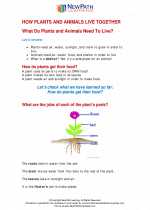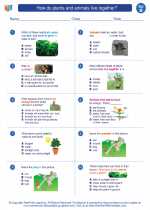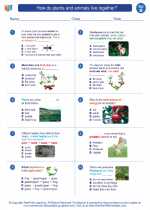How do plants and animals live together? -> minerals
What are Minerals?
Minerals are naturally occurring inorganic substances with a definite chemical composition and a crystalline structure. They are the building blocks of rocks and are formed through geological processes such as cooling and solidification of molten rock, precipitation from water, or metamorphism.
Properties of Minerals
Minerals have several characteristic properties that help in their identification:
- Color: The color of a mineral can vary, but it is not the most reliable property for identification due to impurities.
- Luster: It refers to how light is reflected from the surface of the mineral. Common types of luster include metallic, glassy, pearly, and dull.
- Hardness: The ability of a mineral to resist scratching. This property is measured using the Mohs scale of hardness, which ranges from 1 (softest, talc) to 10 (hardest, diamond).
- Cleavage and Fracture: Cleavage refers to the way a mineral breaks along planes of weakness, while fracture describes how the mineral breaks when no cleavage is present.
- Crystal Form: Some minerals exhibit distinct crystal shapes, such as cubic, prismatic, or tabular forms.
- Specific Gravity: The density of a mineral compared to the density of water.
Types of Minerals
There are over 4,000 known minerals, but they can be classified into major groups based on their chemical composition:
- Silicates: These minerals are the most abundant in the Earth's crust and are composed of silicon and oxygen atoms, often combined with other elements like aluminum, iron, magnesium, or potassium.
- Carbonates: Minerals in this group contain the carbonate ion (CO3) combined with metal ions, such as calcite (CaCO3) and dolomite (CaMg(CO3)2).
- Oxides: Oxide minerals are composed of metal cations and oxygen, such as hematite (Fe2O3) and magnetite (Fe3O4).
- Sulfides: These minerals are made up of metal cations combined with sulfur, such as pyrite (FeS2) and galena (PbS).
- Sulfates: Minerals in this group contain the sulfate ion (SO4) combined with metal ions, such as gypsum (CaSO4·2H2O).
- Native Elements: This group includes minerals that are composed of a single element, such as gold (Au), silver (Ag), and diamond (C).
Uses of Minerals
Minerals have various uses in everyday life and industry:
- Building Materials: Minerals like quartz, feldspar, and limestone are used in construction materials such as cement, concrete, and glass.
- Metals and Alloys: Minerals like iron, copper, and aluminum are essential for producing metals and alloys used in manufacturing and infrastructure.
- Gemstones: Precious and semiprecious minerals like diamond, ruby, and sapphire are valued for their beauty and used in jewelry.
- Fertilizers: Minerals like phosphate and potash are used in agricultural fertilizers to enhance soil fertility.
- Energy Production: Minerals such as coal, uranium, and natural gas are vital for energy production.
Study Guide
Here are some key points to remember when studying minerals:
- What are the defining characteristics of minerals?
- How are minerals classified based on their chemical composition?
- What are the major uses of minerals in society?
- Can you identify common minerals based on their physical properties?
[Minerals] Related Worksheets and Study Guides:
.◂Science Worksheets and Study Guides Second Grade. How do plants and animals live together?
Study Guide How do plants and animals live together?
How do plants and animals live together?  Worksheet/Answer key
Worksheet/Answer key How do plants and animals live together?
How do plants and animals live together?  Worksheet/Answer key
Worksheet/Answer key How do plants and animals live together?
How do plants and animals live together?  Worksheet/Answer key
Worksheet/Answer key How do plants and animals live together?
How do plants and animals live together? 

 Worksheet/Answer key
Worksheet/Answer key
 Worksheet/Answer key
Worksheet/Answer key
 Worksheet/Answer key
Worksheet/Answer key

The resources above cover the following skills:
LIFE SCIENCE (NGSS)
Ecosystems: Interactions, Energy, and Dynamics
Students who demonstrate understanding can:
Plan and conduct an investigation to determine if plants need sunlight and water to grow.